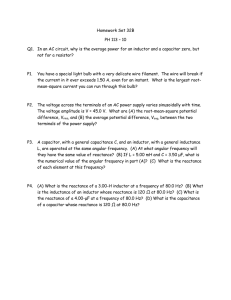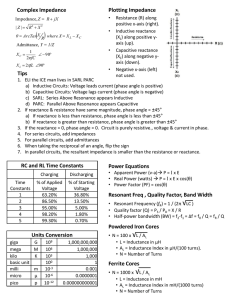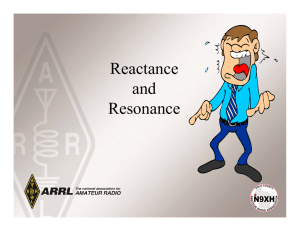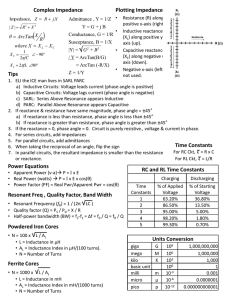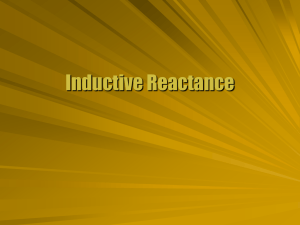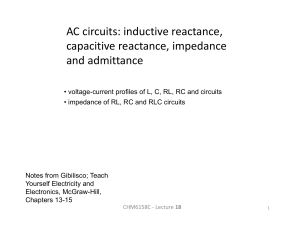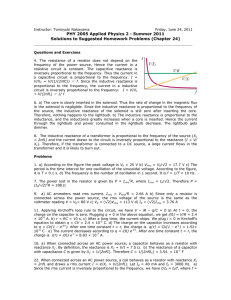Inductive Reactance
advertisement
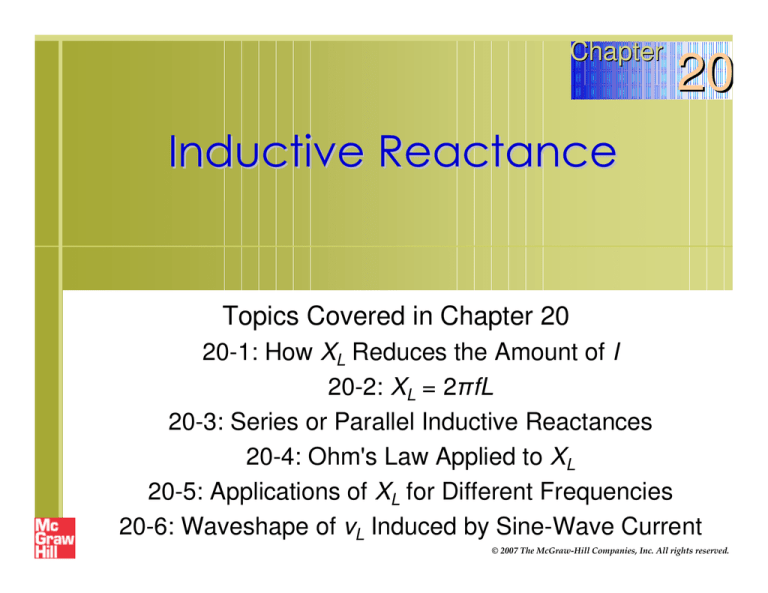
Chapter 20 Inductive Reactance Topics Covered in Chapter 20 20-1: How XL Reduces the Amount of I 20-2: XL = 2πfL 20-3: Series or Parallel Inductive Reactances 20-4: Ohm's Law Applied to XL 20-5: Applications of XL for Different Frequencies 20-6: Waveshape of vL Induced by Sine-Wave Current © 2007 The McGraw-Hill Companies, Inc. All rights reserved. 20-1: How XL Reduces the Amount of I An inductance can have appreciable XL in ac circuits to reduce the amount of current. The higher the frequency of ac, and the greater the L, the higher the XL. There is no XL for steady direct current. In this case, the coil is a resistance equal to the resistance of the wire. McGraw-Hill © 2007 The McGraw-Hill Companies, Inc. All rights reserved. 20-1: How XL Reduces the Amount of I In Fig. 20-1 (a), there is no inductance, and the ac voltage source causes the bulb to light with full brilliance. In Fig. 20-1 (b), a coil is connected in series with the bulb. The coil has a negligible dc resistance of 1 Ω, but a reactance of 1000 Ω. Now, I is 120 V / 1000 Ω, approximately 0.12 A. This is not enough to light the bulb. In Fig. 20-1 (c), the coil is also in series with the bulb, but the battery voltage produces a steady dc. Without any current variations, there is no XLand the bulb lights with full brilliance. Copyright © The McGraw-Hill Companies, Inc. Permission required for reproduction or display. Fig. 20-1: 20-2: XL = 2πfL The formula XL = 2πfL includes the effects of frequency and inductance for calculating the inductive reactance. The frequency is in hertz, and L is in henrys for an XL in ohms. The constant factor 2π is always 2 x 3.14 = 6.28. The frequency f is a time element. The inductance L indicates the physical factors of the coil. Inductive reactance XL is in ohms, corresponding to a VL/IL ratio for sine-wave ac circuits. 20-3: Series or Parallel Inductive Reactances Since reactance is an opposition in ohms, the values XL in series or in parallel are combined the same way as ohms of resistance. With series reactances, the total is the sum of the individual values as shown in Fig. 20-5 (a). The combined reactance of parallel reactances is calculated by the reciprocal formula. Fig. 20-5 20-4: Ohm's Law Applied to XL The amount of current in an ac circuit with only inductive reactance is equal to the applied voltage divided by XL. I = V/XL = 1 A I = V/XLT = 0.5 A Fig. 20-6: Copyright © The McGraw-Hill Companies, Inc. Permission required for reproduction or display. I1 = V/XL1 = 1 A I2 = V/XL2 = 1 A IT = I1 + I2 = 2 A 20-5: Applications of XL for Different Frequencies The general use of inductance is to provide minimum reactance for relatively low frequencies but more for higher frequencies. If 1000 Ω is taken as a suitable value of XL for many applications, typical inductances can be calculated for different frequencies. Some are as follows: 2.65 H 60 Hz Power-line frequency 160 mH 10,000 Hz Medium audio frequency 16 mH 10,000 Hz High audio frequency 1.6 µH 100 MHz In FM broadcast band 20-6: Waveshape of vL Induced by Sine-Wave Current Induced voltage depends on rate of change of current rather than on the absolute value if i. A vL curve that is 90°out of phase is a cosine wave of voltage for the sine wave of current iL. The frequency of VL is 1/T. The ratio of vL/iL specifies the inductive reactance in ohms. 20-6: Waveshape of vL Induced by Sine-Wave Current di/dt for Sinusoidal Current is a Cosine Wave di/dt Current vL = L 0 di dt θ Sinusoidal Current Iinst. = Imax × cos θ Copyright © The McGraw-Hill Companies, Inc. Permission required for reproduction or display. 20-6: Waveshape of vL Induced by Sine-Wave Current Amplitude Inductor Voltage and Current 0 Time Θ = -90° I V I Copyright © The McGraw-Hill Companies, Inc. Permission required for reproduction or display. V 20-6: Waveshape of vL Induced by Sine-Wave Current Application of the 90°phase angle in a circuit The phase angle of 90°between VL and I will always apply for any L with sine wave current. The specific comparison is only between the induced voltage across any one coil and the current flowing in its turns. 20-6: Waveshape of vL Induced by Sine-Wave Current Current I1 lags VL1 by 90°. Current I2 lags VL2 by 90°. Current I3 lags VL3 by 90°. NOTE: I3 is also IT for the seriesparallel circuit. Fig. 20-8
